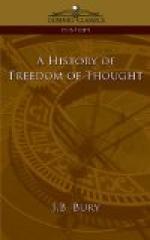Loisy is the most prominent figure in a growing movement within the Catholic Church known as Modernism—a movement which some think is the gravest crisis in the history of the Church since the thirteenth century. The Modernists do not form an organized party; they have no programme. They are devoted to the Church, to its traditions and associations, but they look on Christianity as a religion which has developed, and whose vitality depends upon its continuing to develop. They are bent on reinterpreting the dogmas in the light of modern science and criticism. The idea of development had already been applied by Cardinal Newman to Catholic theology. He taught that it was a natural, and therefore legitimate, development of the primitive creed. But he did not draw the conclusion which the Modernists draw that if Catholicism is not to lose its power of growth and die, it must assimilate some of the results of modern thought. This is what they are attempting to do for it.
Pope Pius X has made every effort to suppress the Modernists. In 1907 (July) he
[200] issued a decree denouncing various results of modern Biblical criticism which are defended in Loisy’s works. The two fundamental propositions that “the organic constitution of the Church is not immutable, but that Christian society is subject, like every human society, to a perpetual evolution,” and that “the dogmas which the Church regards as revealed are not fallen from heaven but are an interpretation of religious facts at which the human mind laboriously arrived”—both of which might be deduced from Newman’s writings—are condemned. Three months later the Pope issued a long Encyclical letter, containing an elaborate study of Modernist opinions, and ordaining various measures for stamping out the evil. No Modernist would admit that this document represents his views fairly. Yet some of the remarks seem very much to the point. Take one of their books: “one page might be signed by a Catholic; turn over and you think you are reading the work of a rationalist. In writing history, they make no mention of Christ’s divinity; in the pulpit, they proclaim it loudly.”
A plain man may be puzzled by these attempts to retain the letter of old dogmas emptied of their old meaning, and may think it natural enough that the head of the Catholic
[201] Church should take a clear and definite stand against the new learning which, seems fatal to its fundamental doctrines. For many years past, liberal divines in the Protestant Churches have been doing what the Modernists are doing. The phrase “Divinity of Christ” is used, but is interpreted so as not to imply a miraculous birth. The Resurrection is preached, but is interpreted so as not to imply a miraculous bodily resurrection. The Bible is said to be an inspired book, but inspiration is used in a vague sense, much as when one says that Plato was inspired; and the vagueness of this new idea of inspiration is even put forward as a merit. Between the extreme views which discard the miraculous altogether, and the old orthodoxy, there are many gradations of belief. In the Church of England to-day it would be difficult to say what is the minimum belief required either from its members or from its clergy. Probably every leading ecclesiastic would give a different answer.




